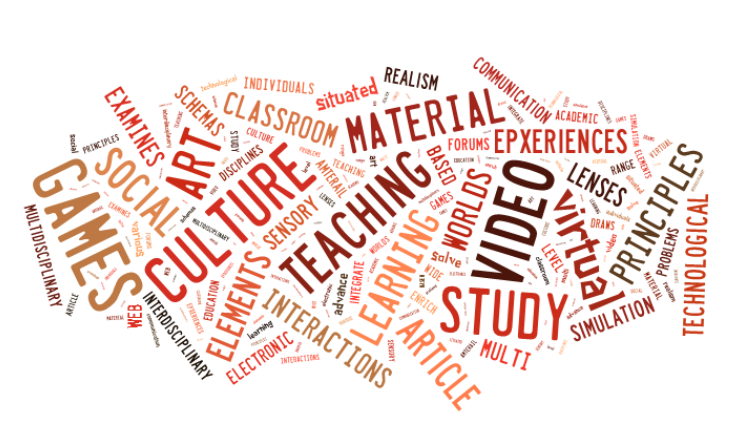Action Packed Art Education: Shooting for Higher Learning through Material Culture and Video Games
Keywords:
Material Culture, Visual Culture, Preservice Art EducationAbstract
In this article, I describe how to teach elements and principles of art through the virtual worlds of video games, how games are part of material culture, experiences of teaching video games in the classroom and their social interactions. At the end of this article, I list ideas and offer a lesson plan using video games to promote social justice. Through virtual and technological lenses, material culture examines multi-sensory simulation, situated learning, and social realism gaming schemas (Parks, 2008). Web based electronic communication can become multidisciplinary and interdisciplinary study through forums about video games and how individuals solve problems together to advance to the next level. Through video games, material culture studies integrate with various academic disciplines and draws on a wide range of gaming study that enrich learning in art education.
References
"Anderson, L.W., & Krathwohl, D.R. (Eds). (2001). A taxonomy for learning, teaching and assessing: A revision of bloom’s taxonomy of educational objectives: Complete edition. New York: Longman.
Bandura, A. (1989). Social cognitive theory. In R. Vasta (Ed.), Annals of Child Development, 6. Six theories of child development (pp. 1–60). Greenwich, CT: JAI Press.
Bandura, A. (1977). Social learning theory. Englewood Cliffs, NJ: Prentice Hall.
Bandura, A. (1997). Self-efficacy: The exercise of control. New York, NY: W. H. Freeman.
Bilal, W. (2014). Domestic tension. Retrieved from: http://wafaabilal.com/html/domesticTension.html
Blandy, D, (2012). Experience, discover, interpret, and communicate. In T. Quinn, J. Ploof and L. Hochtritt (Eds.), Art and social justice education: Culture as commons (pp.28-34). New York, NY: Routledge.
Bolin, P., and Blandy, D. (2003). Beyond Visual culture: Seven Statements of Support for Material Culture Studies in Art Education. Studies in Art Education, 44(3), 246-263.
Dikovitskaya, Margaret (2005). Visual Culture: The Study of the Visual after the Cultural Turn (1st ed.). Cambridge, Ma: The MIT Press.
Frasca, G. (2004). Videogames of the oppressed: Critical thinking, education, tolerance, and other trivial issues. In P. Harrigan, & N. Wardrip-Fruin (Eds.), First person: New media as story,performance, and game, 85-94. Cambridge, MA: MIT Press. Retrieved April 4, 2015, from http://www.electronicbookreview.com/thread/firstperson/modw
Games for Change. (2015, October 12). Games. Retrieved from http://www.gamesforchange.org/play/
Kader, T. (2000). Material culture studies and art education: Examining the cultural artifacts of the bohra. Marilyn Zurmuehlen Working Papers in Art Education, 2000(1), 1-11.
Kim, T. & Axelrod, S. (2005). Direct Instruction: An Educators’ Guide and a Plea for Action. The Behavior Analyst Today, 6,(2), Page 111-123.
London, S. (2015). Advantages of teamwork. (2015, July 21). Retrieved from https//www.boundless.com/management/textbooks/boundless-management-textbook/groups-teams-and-teamwork-51/advantages-of-teamwork-259-4562/
Olson, C.K. (2010). Children’s motivations for video game play in the context of normal development. Review of General Psychology, 14(2), Jun 2010, 180-187.
Parks, N.S. (2009). Beyond violence, serious video games and youth culture. Journal of Cultural Research in Art Education, 27, 82-93.
Parks, N.S. (2008). Video games as reconstructionist sites of learning in art education. Studies in Art Education, 49(3), 235-250.Rothwell, W.J. (2008). Adult learning basics. Alexandria, VA: ASTD Press.
Squire, K.D. (2008). Video game-based learning: An emerging paradigm for instruction. Performance Improvement Quarterly, 21(2), 7-36.
Sweeny, R. (2010). Pixellated Play: Practical and Theoretical Issues regarding Videogames in Art Education. Studies in Art Education, 51(3), 262-274.
Tavin, K.M. (2005). Opening Re-Marks: Critical Antecedents of Visual Culture in Art
Education. Studies in Art Education, 47(1), 5-22.
Totten, G. (2007). Memorial boxes and guarded interiors: Edith wharton and material culture. Tuscaloosa: University of Alabama Press.
Ulbricht, J. (2007). Reflections on visual and material culture: An example from southwest chicago. Studies in Art Education, 49(1), 59-72.
Warburton, W. (2012) Growing Up Fast and Furious. Oxford, UK: Taylor & Francis.

Downloads
Published
Issue
Section
License
Authors who publish with this journal agree to the following terms:- Authors retain copyright and grant the journal right of first publication with the work simultaneously licensed under a Creative Commons Attribution License that allows others to share the work with an acknowledgement of the work's authorship and initial publication in this journal.
- Authors are able to enter into separate, additional contractual arrangements for the non-exclusive distribution of the journal's published version of the work (e.g., post it to an institutional repository or publish it in a book), with an acknowledgement of its initial publication in this journal.
- Authors are permitted and encouraged to post their work online (e.g., in institutional repositories or on their website) prior to and during the submission process, as it can lead to productive exchanges, as well as earlier and greater citation of published work (See The Effect of Open Access).

